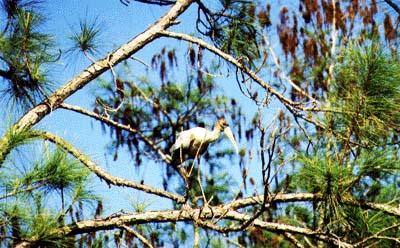
The bill is also utilitarian. Wood storks feed by wading in water between 10 and 20 inches deep. A stork moves its partly open bill in the water until it touches a fish. Then the sensitive bill snaps shut with incredible speed a mere fortieth of a second, according to stork expert M. Philip Kahl. As weather conditions change, storks must often travel great distances to find food for their young. A peerless flyer among wading birds, the stork takes advantage of thermals, or vertical air currents, gliding for miles without flapping its wings. Wood storks are on the endangered species list, but they are stabilizing in the United States. The United States has between 5,000 and 7,000 breeding pairs. If they reach a self-sustaining population of 10,000 pairs, the birds would be removed from the endangered species list.
In North America, two separate wood stork populations exist. The larger population breeds in southern Mexico, dispersing after the nesting season to Texas, Louisiana, Arkansas, Arizona and California. The southeastern population is centered in Florida, with colonies in Georgia and South Carolina. Wood storks are also found in Central America and as far south as northern Argentina.
Wood stork populations in southern Florida have been declining for the past 60 years because of widespread habitat damage, particularly the drainage of wetlands. About the same time that nesting rates in Florida were hitting an all-time low, nests were discovered in Georgia and South Carolina. In a hopeful sign this year, biologists counted 953 nests in South Carolina and 1,475 nests in Georgia together composing about 40 percent of the total wood stork nesting in the United States.
Although the wood stork's status has stabilized, the quality of wintering habitats in south Florida may yet prevent the wood stork's recovery. Notes South Carolina biologist Tom Murphy, "We may be producing lots of chicks up here, but if they all die during the winter, then you're back to the same population size, and it doesn't matter how we manage in South Carolina."